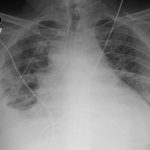Empyema
History of present illness:
A 51-year-old male with congestive heart failure, previous myocardial infarctions, and a questionable history of chronic obstructive pulmonary disease presented to the emergency department with a chief complaint of shortness of breath. His shortness of breath developed the morning of presentation, and was associated with midsternal chest pain radiating to his right shoulder. Vital signs were significant for a temperature of 36.5ºC, heart rate of 115/minute, respiratory rate of 26/minute, and oxygen saturation of 92% on 15-liter facemask. His exam demonstrated decreased breath sounds on the right side without wheezing. An immediate chest X-ray was performed.
Significant findings:
The chest X-ray shows a large fluid collection in the right lung demonstrated by the opacification that blunts the costophrenic angle on the right side. There is also a meniscus present, which is generally indicative of fluid. Chest computed tomography (CT) demonstrated an infiltrate with a mixture of densities within the same collection, consistent with a loculated effusion and concerning for an empyema.
Discussion:
The patient’s labs were significant for an elevated white blood cell count of 20,500/mm3. He was started on broad-spectrum antibiotics and diagnosed with an empyema. He was admitted to the ICU where he underwent thoracentesis and eventual chest tube placement.
Empyema is defined as a pleural effusion which is grossly purulent or contains bacteria visualized on gram stain.1,2 Empyemas are most commonly associated with concurrent pneumonia or invasive procedures such as thoracotomy.2 Untreated cases often develop loculations and scarring of the pleura.1 Patients with empyema typically present with fever, shortness of breath, productive cough, and/or chest pain.2 Imaging is key in diagnosis, with lateral decubitus radiographs being able to detect as little as 50 mL of fluid compared to 200 mL of fluid needed in an anteroposterior chest radiograph. 2 Ultrasound can also be used to identify loculations. Chest CT can be used to optimally evaluate an empyema.2 Free-flowing fluid warrants sampling by thoracentesis.1,2
Empiric antibiosis should cover pseudomonas and anaerobes, with methicillin-resistant Staphylococcus aureus coverage if suspected.2 All empyemas require invasive procedures for treatment, the least invasive being chest tube placement until drainage is less than 50 mL/day.2 Unresolved empyema after chest tube placement may require video-assisted thoracoscopic surgery (VATS) or thoracotomy with decortication.1,2
Topics:
Empyema, pleural effusion, shortness of breath, chest tube, thoracentesis.
References:
- Light RW. Parapneumonic Effusions and empyema. Proc Am Thorac Soc. 2006;3(1):75-80. doi: 10.1513/pats.200510-113JH
- Desai H, Agrawal A. Pulmonary emergencies: pneumonia, acute respiratory distress syndrome, lung abscess, and empyema. Med Clin North Am. 2012;96(6):1127-1148. doi: 10.1016/j.mcna.2012.08.007





